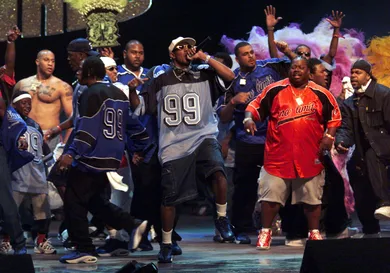Fabolous is planning to take fans back to the '90s with his upcoming album The Young OG Project, due out on Christmas day. With the '90s era of hip-hop sitting heavy in his mind, we got Loso to reel off his top five reasons on why he loves the '90s.
Much of what Fabolous mentions can still be found in hip-hop to this day, at least in some form or another, but their birth can be traced back to the '90s. From the fashion choices to the crew lifestyle, these "are the things that helped me fall in love with hip-hop during the '90s," Fabolous says. "I tried to add some elements of those things in the music, but still keep it where it wasn't dated, I wanted it to feel 'now,' but also give you the vibe, different energies. So you'll definitely see that on The Young OG Project, you'll hear some samples, you'll hear some flips. I think overall it's a great project, it's something to rock too through out the holidays. It's gunna pay its dues to the '90s."
Watch the video below, and read on to see Fab's top five. Pre-order The Young OG Project on iTunes.
Crew joints
"I always was a big fan of "Scenario" or "The Symphony," or the ones that had like, The LOX, DMX and Jay. It wasn't about a catchy hook or a melodic flow, it was like just throwing a slab a meat in there to five dogs and they just go in and they all pulling at the meat from each side. Those crew joints had those kinda aspects to it. they also sometimes kinda mixed up the type of artists you'd hear on those joints. "Scenario" to me had animated Busta Rhymes but then it had laid-back Q-Tip on it, you know it had different vibes."
Diversity
"You could have backpack hip-hop, you could have gangster hip-hop, you could have flashy, flossy hip-hop you could have female hip-hop...You just had so many different lanes, for whatever vibes you was on. Whereas now, there's still different lanes, but the mainstream is pretty much in one lane, you have the club and the turn-up music came to the forefront."
Fashion
"There was a wide range of hip-hop brands that started coming to life in '90s, or brands that were built off the back off hip-hop, even if they weren't done by hip-hop pioneers. Later on Jay Z and Diddy has Sean John, Rocawear stuff, but before that there was Karl Kani and Cross Colors and those kind of brands that were kinda marketed through hip-hop and became bigger brands because of their hip-hop affiliation. So that was also dope, and that's one of the things that helped turn hip-hop universal, 'cause it wasn't just the music, it was the look."
Universal
"I think hip-hop spread from just being a regional thing here on the East Coast and on the West Coast, and the South emerged later '90s, I mean they always had they thing going, but where the Cash Moneys and No Limits came about, it showed a different angle of Southern hip-hop and even Southern business in hip-hop. It became universal to me, people started knowing hip-hop across the world. Before that you would say like Michael Jackson and those big pop artists were all around the world, maybe one big hip-hop song goes up. But towards the '90s it started being a big thing, you could go to Japan, you could go to Europe, and hip-hop was finding its way there through the music and through the style."
Collectives
"I feel like the rap crews. The Deathrow, the Bad Boy, the Cash Money, No Limit, even Duck Down, Smif-n-Wessun, there was just different crews in different lanes. The Smif-N-Wessun, Duck Down, Black Moon, Heltah Skeltah, that was like one whole vibe, and then you had Bad Boy, which was Biggie, Craig Mack at first and then it grew to Mase...
The rap crews were really big in the '90s and it showed a big sense of unity too. Everybody wasn't rich, but they looked rich at hear, they was with they boys. The Wu-Tang, man. At the time it was really cool to be like 10, 20 deep, like, really, really cool. People still mobbin' to this day don't get me wrong, but 20 deep at that time, that's how you rolled with your boys. Also, with all these characters, it was like Avengerz of a rap group."
